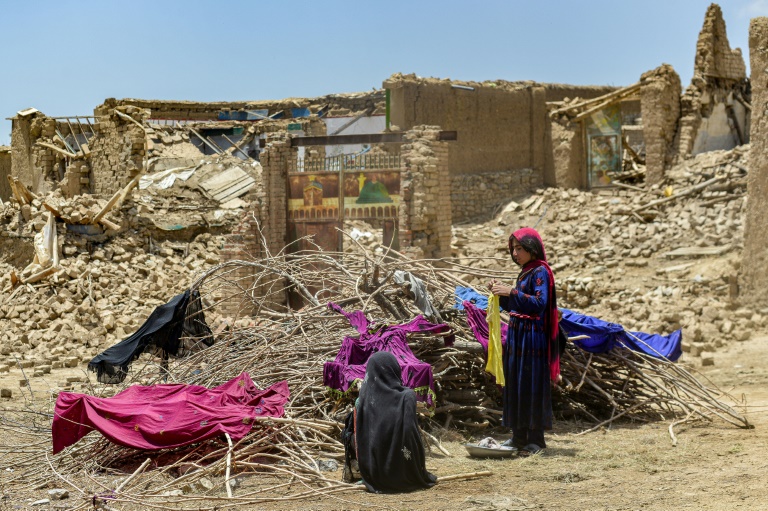Desperate rescuers battled against the clock and heavy rain Thursday to reach cut-off areas in eastern Afghanistan after a powerful earthquake killed at least 1,000 people and left thousands more homeless.
Wednesday’s 5.9-magnitude quake struck hardest in the rugged east, downing mobile phone towers and power lines while triggering rock and mudslides which blocked mountain roads, further hampering rescue operations.
Entire villages have been levelled in some of the worst affected districts, where survivors said they were struggling to find equipment to bury their dead.
“When I came out of my house it was quiet because all the people were buried under their homes. Nothing is left here,” said 21-year-old Zaitullah Ghurziwal.
Afghanistan’s deadliest earthquake in more than two decades poses a huge logistical challenge for the new Taliban government, which has isolated itself from much of the world by introducing hardline rule.
“Getting information from the ground is very difficult because of bad networks,” Mohammad Amin Huzaifa, head of information for badly hit Paktika province, told AFP Thursday.
“The area has been affected by floods because of heavy rains last night… It is also difficult to access the affected sites.”
Authorities say the temblor left at least 3,000 people wounded.
The aid-dependent country saw the bulk of its foreign assistance cut off following the Taliban takeover last August, and even before the earthquake the United Nations warned of a humanitarian crisis that threatened the entire population.
UN Secretary-General Antonio Guterres said the global agency has “fully mobilised” to help.
According to his office, refugee agency UNHCR has dispatched tents, blankets and plastic sheeting; the World Food Programme has delivered food stock for about 14,000 people in Paktika province; and the World Health Organization has provided 10 tonnes of medical supplies sufficient for 5,400 surgeries.
– ‘Nothing to eat’ –
Survivors in Bermal district, a collection of remote mountain villages, said they were struggling to find food, shelter, and equipment to dig graves.
“We did not have even a shovel to dig… so we used a tractor. We buried 60 people yesterday and 30 more are still remaining to be buried,” said Ghurziwal.
“There are no blankets, tents, there’s no shelter. Our entire water distribution system is destroyed. Everything is devastated, houses are destroyed. There is literally nothing to eat.”
Afghan government officials said Thursday that aid flights had landed from Qatar and Iran, while Pakistan had sent trucks carrying tents, medical supplies and food across the border.
“The teams of IEA are on the ground … we are using helicopters and roads to take the aid to affected areas,” government spokesman Bilal Karimi told AFP.
An AFP correspondent reported a military helicopter flying over villages devastated by the earthquake in Bermal.
The earthquake struck areas already suffering the effects of heavy rain, causing rockfalls and mudslides that wiped out hamlets perched precariously on mountain slopes.
Officials say nearly 10,000 houses were destroyed, an alarming number in an area where the average household size is more than 20 people.
“Seven in one room, five in the other room, four in another, and three in another have been killed in my family,” Bibi Hawa told AFP from a hospital bed in the Paktika capital.
“I can’t talk anymore, my heart is getting weak.”
Save the Children said more than 118,000 children were impacted by the disaster.
“Many children are now most likely without clean drinking water, food and a safe place to sleep,” the international charity said.
– Limited capacity –
Even before the Taliban takeover, Afghanistan’s emergency response teams were stretched to deal with the natural disasters that frequently strike the country.
But with only a handful of airworthy planes and helicopters left since they returned to power, any immediate response to the latest catastrophe is further limited.
“We hope that the International Community & aid agencies will also help our people in this dire situation,” tweeted Anas Haqqani, a senior Taliban official.
The United States, whose troops helped topple the initial Taliban regime and remained in Afghanistan for two decades until Washington pulled them out last year, said it was “deeply saddened” by the earthquake and would look for ways to help, including through potential talks with Taliban rulers.
Afghanistan is frequently hit by earthquakes, especially in the Hindu Kush mountain range, near the junction of the Eurasian and Indian tectonic plates.
Scores of people were killed in January when two quakes struck the western province of Badghis.
Afghanistan’s deadliest recent earthquake killed 5,000 in 1998 in the northeastern provinces of Takhar and Badakhshan.









